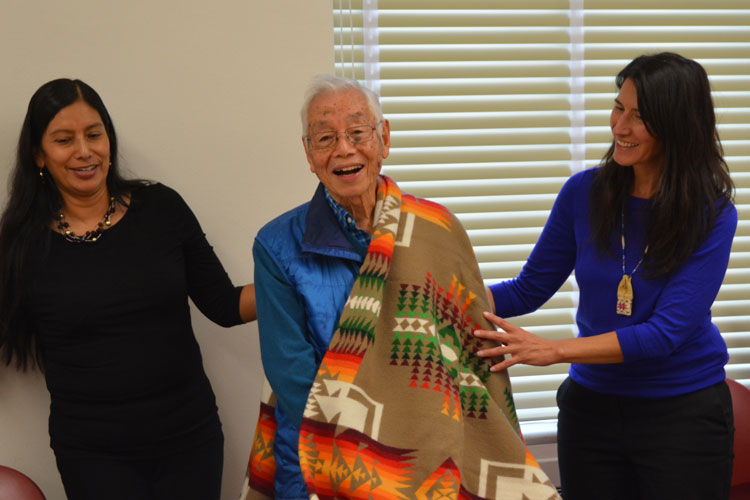New graduate program aims to keep languages from disappearing
Linguistics, ethnic studies and education students, as well as others, will receive training in indigenous language revitalization
July 27, 2018

Haruo Aoki receives blanket from Nez Perce scholars Beth Piatote (right) and Angel Sobotta (left) in November 2017. Aoki is a professor emeritus of East Asian Languages. Piatote was a key faculty member in launching the new designated emphasis in indigenous language revitalization. (UC Berkeley photo by Melani King)
Almost half of the 6,000 languages spoken around the world are considered endangered, according to UNESCO data. In an effort to preserve and nurture languages at risk of disappearing — and serve a growing interest among students — UC Berkeley is offering a new designated emphasis in Indigenous Language Revitalization.
The new program — essentially a graduate minor available to students in any Ph.D. program at Berkeley — is an interdisciplinary collaboration of the departments of Ethnic Studies and Linguistics and the Graduate School of Education. The primary student constituencies are graduate students in these fields and Native American and Indigenous students in these or other fields.
“More than half, maybe even two-thirds, of the graduate linguistics students do their dissertation work on endangered languages,” says Andrew Garrett, a professor of linguistics. Many of them, he adds, are interested in language revitalization or already take part in language revitalization activities.
Beth Piatote, an associate professor of Native American Studies, began to study her heritage language, Nez Perce, in 2002 while a graduate student of literature at Stanford. She worked on the Berkeley committee that designed the designated emphasis and is the inaugural chair of the program.
“One of the unique aspects of the DE is that graduate students from any department can be admitted, and that is important for Native American students who might be enrolled in math or engineering programs but who still want to participate in the language vitality of their own tribal communities,” she says.

Sara Chase (left), one of the first students to participate in the designated emphasis, spent the summer of 2018 at a Hoopa language immersion camp with members of the Hoopa Valley Tribe in northern California. (Photo courtesy of Sara Chase)
The program is designed to equip students with knowledge of the methods, histories, and goals of indigenous language revitalization in global contexts. Students will take a core course in linguistics and an approved elective, and get hands-on experience through practicum or field work. Shortly after the DE was approved this spring, its first cohort of students was admitted: Sara Chase, a Ph.D. candidate in education who works in Hupa, and Julia Nee, a Ph.D. candidate in linguistics who works on Zapotec.
Chase has been involved in the revitalization of the Hupa language spoken by the Hoopa Valley Tribe, of which she is a member. She sees a major benefit in the new program.
“I had hoped that my academic training in education, with a focus on language, literacy and culture, would have given me the time and space to be able to do my revitalization work,” says Chase. “However, I often had to do my language work in addition to and outside of my coursework.” And this is true for other students, she adds.
“The DE will give the institutional support as well as space to be able to focus on such important work that is often ignored or marginalized,” says Chase.
The designated emphasis also will help fill in knowledge gaps in the field of language revitalization.
“From the perspective of linguists, one of the big things that can be gained by students through this DE is exposure to the historical and cultural contexts of language loss that we’re often not trained to learn about or investigate as much in our own research,” says Zachary O’Hagan, a graduate linguistics student and a member of the committee that designed the DE.
“It’s not uncommon for a linguist to be working on an indigenous language and just be focused on documenting or describing it from a linguistic perspective,” O’Hagan says. “Before the DE, there was no broader commitment to revitalizing the language or understanding the context of why it’s endangered in the first place.”
UC Berkeley has long been a leader in study of the indigenous languages of the Americas. The Linguistics Department has supported academic endeavors including the Survey of California and Other Indian Languages, the California Language Archive and the Breath of Life Archival Institute, a program that helps revive dormant languages by recovering archival material for California Indian languages with no or few living first-language speakers. The Native American Studies program in the Department of Ethnic Studies and the School of Education have provided courses and faculty research addressing the historical and cultural contexts of language loss, educational policies related to language and the epistemological and cultural values of indigenous languages. The new designated emphasis will bring all of these elements together in a cohesive field of study.
“Linguists almost everywhere have no formal training in language teaching,” says Garrett. “Linguistics has always been a theoretical discipline rather than an applied discipline. Whereas in the education school, there are people who know a lot from the theoretical point of view and the applied point of view about learning and teaching. Our goal is in supporting the linguists who have the desire and community involvement but want the practical knowledge of doing things that actually work.”
The designated emphasis will bring a more holistic approach to language revitalization.
“Language endangerment can feel like an overwhelming problem to address,” says Piatote. “It is difficult to contemplate the loss of entire lifeworlds of thought and the wealth of philosophical, linguistic, environmental, and medicinal knowledge that comes through these languages. Our intent with the DE is that we will be able to effectively bring the strategies of multiple disciplines to this problem and create a vibrant intellectual community committed to revitalization. The problem is urgent, but not impossible.”